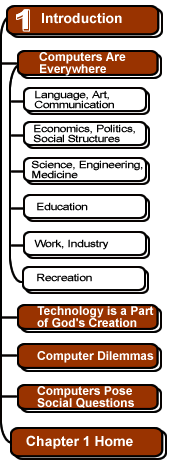

Computers in Language, Art, and Communication (continued)
Computers
and Art
Many artists now use computers in their work.
 The
computer allows the visual artist to combine a number
of media (photography, sketches, etc.) into a single image, a dynamically
changing image, or even 3-D sculptures (rendered on a 2-D screen or
"printed" into a cast object using special equipment). Calvin
Art professor Frank Speyers and some of his students have created the
website www.eyedeas.org
to demonstrate how one must involve the audience when communicating.
This site emphasizes that effective communication necessitates getting
the audience involved, intriguing them, and capturing their attention
visually—all principles that apply equally to live lectures or to websites.
The site is used by art programs at five other academic institutions.
The
computer allows the visual artist to combine a number
of media (photography, sketches, etc.) into a single image, a dynamically
changing image, or even 3-D sculptures (rendered on a 2-D screen or
"printed" into a cast object using special equipment). Calvin
Art professor Frank Speyers and some of his students have created the
website www.eyedeas.org
to demonstrate how one must involve the audience when communicating.
This site emphasizes that effective communication necessitates getting
the audience involved, intriguing them, and capturing their attention
visually—all principles that apply equally to live lectures or to websites.
The site is used by art programs at five other academic institutions.
A musician can use a computer for a variety of creative tasks, from inventing new virtual "instruments" with unique sound characteristics to scoring and orchestrating entire symphonies right at the keyboard (either the QWERTY or the piano type). For instance, Paul Lansky has been called America's foremost electronic composer.
Moreover, musicians can widely disseminate their work with such digital audio compression technologies as MP3, AAC, or Windows Media.
Many actors and dancers, too, are incorporating computer technology, computer networks, and "virtual reality" technology into their work. Consider, for instance, the work of a UK organization, Shiftwork.
These pages were written by Jeffrey L. Nyhoff and Steven H. VanderLeest
and edited by Nancy Zylstra
© 2005 Calvin University (formerly Calvin College), All Rights Reserved.
If you encounter technical errors, contact computing@calvin.edu.